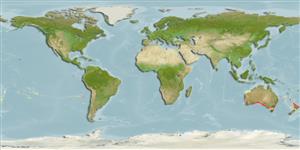Environment: milieu / climate zone / depth range / distribution range
Ecologie
marien rifbewoner; diepte 0 - 400 m (Ref. 58302), usually 15 - 60 m (Ref. 30464). Subtropical; 19°S - 42°S, 114°E - 76°W
Eastern and western South Pacific: Exact distribution unknown because of taxonomic uncertainties.
Grootte / Gewicht / Leeftijd
Maturity: Lm ? range ? - ? cm
Max length : 55.0 cm FL mannelijk / geslacht onbekend; (Ref. 89444); common length : 30.0 cm TL mannelijk / geslacht onbekend; (Ref. 30464)
Dorsale stekels (totaal) : 10; Dorsale zachte stralen (totaal) : 19 - 21; Anale stekels: 3; Anale zachte stralen: 7 - 9; Wervels: 26. Lateral line scales of individuals in the eastern Pacific is 58-65, in western Pacific 61-71 (Ref. 120532). Monochromatic orange-red or with black spots on the dorsal fin (Ref. 43805). Congruent rays of the dorsal fin and a caudal fin with a deep median notch in both sexes (Ref. 43805). Preopercle serrate, but without antrorse spines (Ref. 40817).
Occurs inshore near reefs (Ref. 7300). Benthopelagic and benthic (Ref. 58302). Feeds on plankton and small nekton. Occasionally caught on small hooks when fishing in midwater without sinker and make excellent eating (Ref. 30464). Its abundant gillrakers and stomach contents characterize it as an opportunistic pelagic polyphagic-zooplanktivorous predator (Rojas et al. 1998a, c) (Ref. 89357).
Levenscyclus en paargedrag
Maturiteit | Voortplanting | Paaien | Eieren | Fecunditeit | Larven
Paxton, J.R., D.F. Hoese, G.R. Allen and J.E. Hanley, 1989. Pisces. Petromyzontidae to Carangidae. Zoological Catalogue of Australia, Vol. 7. Australian Government Publishing Service, Canberra, 665 p. (Ref. 7300)
Status op de Rode Lijst van het IUCN (Ref. 130435: Version 2024-1)
Gevaar voor de mens
Harmless
Gebruik door de mens
Visserij: commercieel
Tools
Speciale rapporten
Download XML
Internetbronnen
Estimates based on models
Preferred temperature (Ref.
123201): 16 - 23.2, mean 17.9 °C (based on 250 cells).
Fylogenetische diversiteitsindex (Ref.
82804): PD
50 = 0.6250 [Uniqueness, from 0.5 = low to 2.0 = high].
Bayesian length-weight: a=0.01349 (0.00618 - 0.02945), b=3.00 (2.81 - 3.19), in cm total length, based on LWR estimates for this (Sub)family-body shape (Ref.
93245).
Trofisch niveau (Ref.
69278): 3.9 ±0.63 se; based on food items.
Weerstandsvermogen (Ref.
120179): laag, minimale populatieverdubbelingstijd 4,5-14 jaar (Preliminary K or Fecundity.).
Fishing Vulnerability (Ref.
59153): Moderate vulnerability (44 of 100).
Nutrients (Ref.
124155): Calcium = 20.5 [11.7, 42.9] mg/100g; Iron = 0.581 [0.295, 1.033] mg/100g; Protein = 19.1 [17.3, 20.8] %; Omega3 = 0.268 [0.155, 0.461] g/100g; Selenium = 24.1 [12.5, 46.4] μg/100g; VitaminA = 64 [22, 230] μg/100g; Zinc = 0.568 [0.374, 0.872] mg/100g (wet weight);
